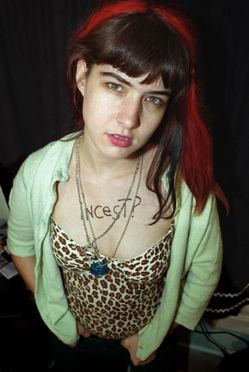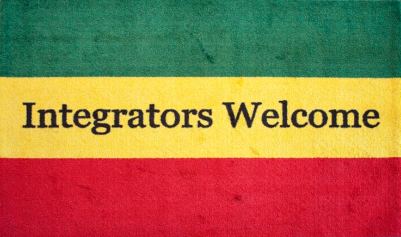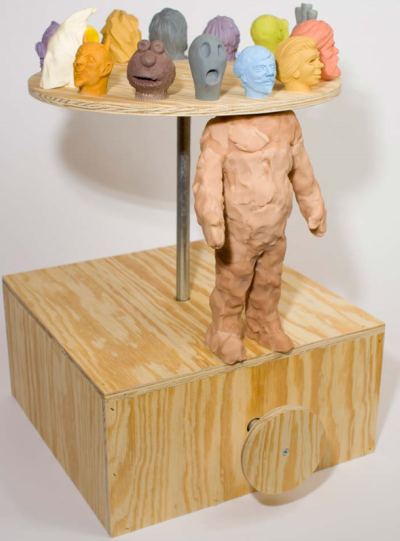We are what we eat but also what we reject, admire and aspire to be.
I.D.: Individual Demographics
at Seattle’s Greg Kucera Gallery is about self, an identity that’s imagined, implied, cataloged, remembered or projected outward like a fog machine.
For Anne Appleby, color carries the world. In Faded Sweet Pea (oil/wax on four panels, each 16 inches square, 2008) there is a homage to the dying in the layered mutations of her shadings, impossible to see reproduced.
Nola Avienne is not interested in elegies. As she notes in her artist statement, some collectors buy art because they want to invest in a brand, which presumably has a good chance of rising in value.
If the artist has become a commodity why not circumvent the art altogether and literally own a piece of the artist?
Step right up, folks. Her Donor Wall Project features small blood portraits of 72 artists. Framed in white and hung in a grid, these expressive abstractions range from light-struck to the darkly clotted.
I love Alice Wheeler‘s large color print titled, Kathleen Hanna at Home, Olympia, 1993.
Light makes a halo around her red henna hair, and the look on her
beautiful young face is pensive. On her chest, however, she scribbled
the word, “incest,” followed by a question mark.
 Wheeler’s subjects confront the dark but stay jaunty. There’s an
Wheeler’s subjects confront the dark but stay jaunty. There’s an
up-and-at-’em vibe to her work that constitutes a world view. Neither
rain nor sleet nor snow nor incest can keep a good girl down.
Matt Browning investigates the rituals of his skate-boarding, pot-smoking, beer-chugging and male-bonded suburban youth. Leave No Trace is a small wooden box he carved for a secret stash. The original must have been strictly utilitarian, but its recreation carries the ethos of the moment lightly, when he and his buddies huddled around a ritualized object, seeking a (collective) high.
Browning’s work proceeds from the most basic questions: Who am I and where did I come from? His story is common, but his delivery is rare.
In the horizontal green yellow and red colors of the Ethiopian flag, Jack Daws created a welcome mat. Set in black lettering across the front is a qualification on the invitation: INTEGRATORS WELCOME.
 Who’s on the out looking in? All the hetros who hang with heteros only, and the reverse. Also not welcome are men who don’t want women at the party, the young who shun the old, the white who know no others, the rich who would not hobnob with the poor, the fleet-foot who look down on the lame.
Who’s on the out looking in? All the hetros who hang with heteros only, and the reverse. Also not welcome are men who don’t want women at the party, the young who shun the old, the white who know no others, the rich who would not hobnob with the poor, the fleet-foot who look down on the lame.
What about those who count as friends no one covered in feathers, scales or fur? No one who swims, flies or runs on four legs?
Scratch out their names.
That’s pretty much everybody. A welcome to all becomes welcome to the few who live on the wild side of inclusion. Thus, a door mat is a rallying cry to expanded consciousness, and what’s flat on the floor aspires to higher ground.
Leigh Bowery was the king/queen of the London club scene in the early 1990s.
Late one night in full regalia, he turned around from the bar and ran into Mick Jagger.
Startled, Jagger said, “Out of my way, freak.”
Bowery replied, “Out of my way, fossil.”
The oft-told exchange is a moment that crystallized a cultural
shift. In the new world which is so much more fun than the old, only a
fossil would call Bowery a freak.
Four of Fergus Greer’s portraits of Bowery
are in the show. Shot as promotionals, they are now themselves art.
Through Greer’s lens we know Bowery, a man constructed through the
high-life personnas of his clothes.
Anthonly Giocolea’s small color photograph from 2006, Grave Diggers, is a moment that becomes a world. A group of young males in private school uniforms cut loose in a woodpile.
Giocolea
appears to see them as they want to see themselves – exuberant and
wild. The top buttons of their pressed shirts are undone, and their
shined shoes ready to be scuffed. And yet, they are playing in a wood
pile, not a wood. Their class constraints them from a walk on a wilder
side.
In his childhood, Glenn Ligon disappeared into his desire. His Self Portrait at 11 Years Old (2004) is a stenciled, pulp-paper painting of Stevie Wonder. It’s a rendering born of love.
With every fiber of his nerdy, black, gay body, Ligon longed to be or (failing that) be with his hero.
Dan Webb makes light of the weighty matter of identity with a New You Machine.
Above a stocky male torso is a lazy Susan of choices for heads. The
visitor who turns the crank can turn a pinched consciousness into an
expansive one, a clown into a philosopher king.
 In AY CHIHUAHUA from 1998, Hugo Ludena
In AY CHIHUAHUA from 1998, Hugo Ludena
caught the downside of sexually inexperienced heterosexuals celebrating
wedlock. They both rear back in horror as a champagne bottle, cork
popped, explores in an orgiastic upward trajectory. Neither is ready
for what in the course of their narrow lives may not occur.
For Chad States,
making art begins with a question. On Craig’s List, he queried, “Are
you masculine?” The subjects he ended up photographing posed themselves
and wore what struck them as appropriate.
These photos are one-two punch. There’s the image and what the subject says about the image. Luke
sits naked in an easy chair and stares provocatively at the male
photographer. Does Luke protest too much? That’s a come-hither look if
I’ve ever seen one.
Luke:
I am masculine because I abandon women
after taking their love. Because when you study Freud you don’t let him
study you. Because I study philosophy not literature.
Without the text, Luke would be one more guy in a chair. With it, he is, in the Diane Arbus sense, terrific.
Previous on the show (Tom of Finland), here.



Leave a Reply